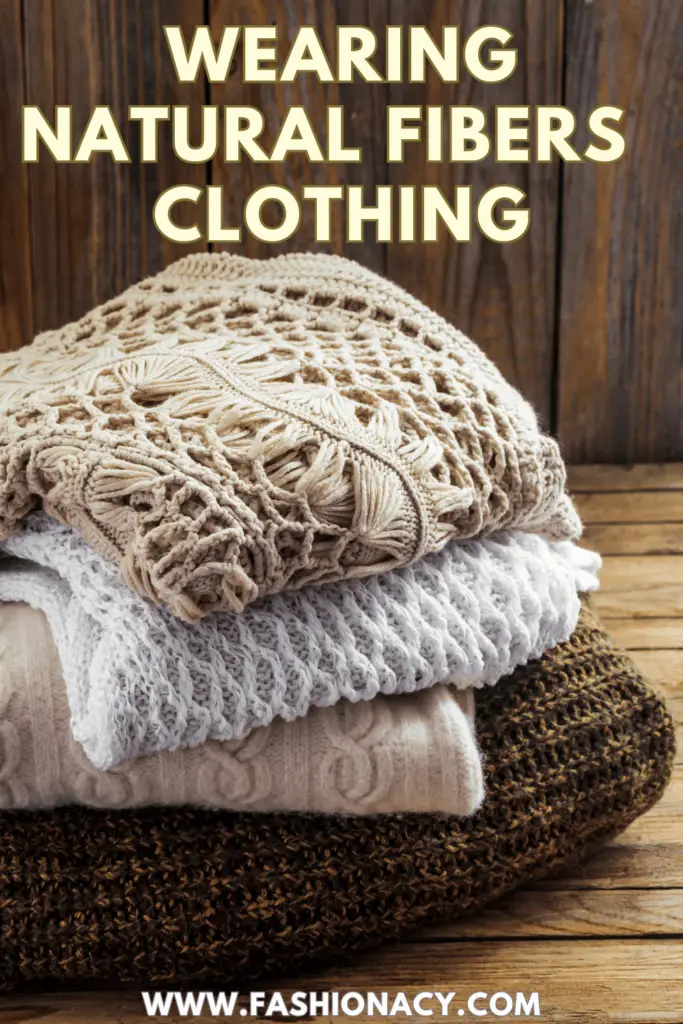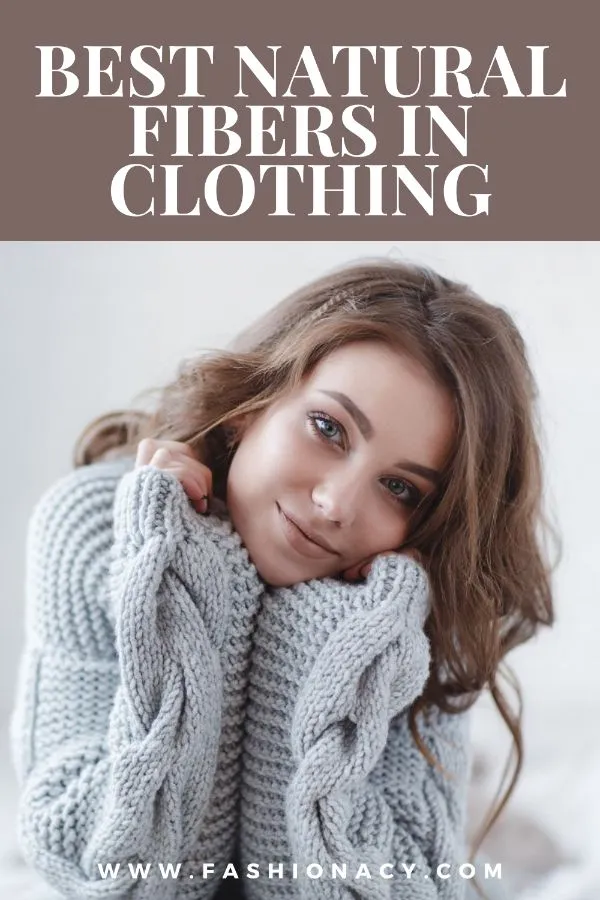
In this article, I’d like to discuss wearing only natural fibers and the best natural fibers in clothing.
I’ll go through a few of the most common, such as cotton, linen, wool, cashmere, and silk.
I’ll explain why I like them and why I believe they’re necessary for a long-lasting wardrobe. Then there’s the question of how to determine which fibers are of the best possible quality.
Let’s start with why I believe they’re so significant.
Why Use Natural Fibers in Clothing?
Natural fibers are highly advantageous for a long-lasting wardrobe, especially when compared to their synthetic equivalents.
They have so many fantastic characteristics that make them an excellent pick. Among them are the following:
- When done correctly, they’re much easier to care.
- They have a tendency to last longer.
- They decompose naturally.
- They’re more environmentally friendly.
- They’re more eco sustainable than synthetic fibers.
- They’re also less hazardous to our health and the environment.
Some natural fibers are termed self-cleaning because they include antimicrobial qualities that allow us to wash them less frequently, extending the piece’s lifespan.
Let’s have a look at some of my favorite natural fibers and how I go about identifying the best ones.
Cashmere
Cashmere is one of my favorite fabrics. It’s just incredibly gentle on the skin. It’s very pleasant to wear, and it’s both breathable and warm. When it comes to sweaters, coats, and blazers, I believe it is by far one of the greatest fabrics to choose.
The softness of good quality cashmere derives from the length of the fibers, and the best cashmeres use long thin fibers.
It should also have a thick, dense weave.
You can evaluate the fabric’s strength by pulling on it a little bit; higher-quality cashmere will bounce back. It won’t lose its shape or leave a mark where your hands used to be.
You can also look at the tag to see if it’s 2-ply or 1-ply.
Because 1-ply is thinner, it is more likely to develop holes. However, if you come across a terrific offer on cashmere and think it’s almost too good to be true, it’s most likely a 1-ply. It could be thin, and it could be missing some of the other identifying characteristics of high-quality cashmere.
Keep it in mind, and pay great attention to each and every aspect. If you buy secondhand, you’ll have an easier time finding high-quality cashmere at a reasonable price.
Wool
Cashmere is technically a wool because it comes from an animal, but for the purposes of this article, I’m referring to non-cashmere sweaters and coats.
Wool is more durable than cashmere and will last for a longer period of time.
They’re made from a variety of animals, and there’s a lot more textural variability than there is with cashmere.
Merino, which will be extremely fine, will also be the highest-end wool. The higher the quality of wool, the finer it is. As a result, you’ll see names like fine merino wool and extra fine merino wool at the top of the list.
Check the label to make sure the wool is 100 percent wool or 100 percent natural fiber to ensure its quality. It’s fine if the wool is blended with cashmere or another natural fiber.
Wool should be dense and spring back when slightly pulled. It should not be left with a large mark were your hands were, just like cashmere.
Dense and tight weave is ideal. When it comes to sweaters, especially sweaters made of natural fabrics, you don’t want anything that are too flimsy.
Things should be very cleanly knitted and also quite dense, since this allows the fabric to survive longer through several wears and washes. It simply aids in the stretching of the item.

Silk
Silk is one of my favorite fabrics, especially for tops. When it comes to bottoms, I find that they can be a little too warm, a little too suffocating.
I try to avoid it in my pants and skirts unless they have a lining. But when it comes to tops, I adore it.
It’s a beautiful way to add texture and visual appeal to an outfit, in my opinion. I have a couple of silk pieces that I’ve had for a long time and absolutely adore.
If you’re tired of working with the same textures, this is a fabric you should consider adding to your wardrobe. It’s also a terrific method to break up thicker knits, which is very useful in the summer.
The weight of silk determines its quality, and it can be difficult to obtain that information easily available. Most retailers are adamant about not giving it up. It’s not on the tag, and it’s only found on very few websites.
The quickest way for me to judge the quality of silk is to feel its weight in my hands.
It should have a substantial feel to it, not be too thin, and be really soft. It should be opaque, especially if the color is darker.
When you hold it up to the light, you shouldn’t be able to see totally through it. You’ll get some transparency, especially if it’s a lighter-colored top, but your hand on the opposite side of the shirt shouldn’t be visible.
This usually indicates that the fabric is a touch too thin to last more than a few seasons.
Linen
For the summer, linen is without a doubt my favorite fabric. And there’s a compelling rationale for it.
Because it automatically gathers up to 20% of the moisture in the air and on our bodies before it starts to feel wet, it’s commonly referred to as nature’s natural wicking fabric.
If you’ve ever worn linen and then cotton in a particularly hot, humid region, you’ll notice that the cotton gets wet, sticky, and drapey faster than the linen. This is why.
Even though it wrinkles a lot, I truly enjoy it. It’s a must-have for me when the weather becomes hot.
When linen gets wet, it becomes even stronger, which is ideal for when you’re wearing it in really hot, humid weather.
It also has antibacterial qualities, which aid in the removal of odors and stains.
I should also remark that wool and cashmere have some of the same characteristics, which is fantastic because it extends the life of the garment. You don’t acquire that nasty sweater scent as quickly as you might think.
Linen is a fabric that breathes well. It allows for easy air flow, making it ideal for year-round wear, especially when layered with wool during the colder months.
Identifying the country of origin might help you spot high-quality linen.
France and Belgium are thought to be the best places to cultivate flax, the plant from which linen is created. Ireland and Italy are regarded as the top flax weavers in the world.
When looking at a piece of linen, the color should be even and rich. Frosting, or a color change in specific sections of the fabric, is a prevalent issue with various linens due to their difficulty in dyeing.
If the linen is black, it was most likely colored with sulfur dyes, which can weaken the fabric and convert into sulfuric acid, which will eat the fabric if not neutralized correctly after coloring.
Keep that in mind, and keep an eye out for any yellowing on white linens, as such deterioration is irreversible.
Real linen wrinkles when you touch it, crush it in your hands, and then let it go, but it also springs back slightly.
Because it is a moisture wicking fabric, it should feel cool to the touch because it is absorbing moisture from the environment.
Cotton
Cotton is the last but not least.
Cotton is one of my favorite fabrics, and I wear it all year long. It’s lightweight and breathable, similar to linen, and it’s simple to layer up or down to insulate or allow oneself to breathe.
Even when I layer my cotton pieces, I retain the breathability that I value in my apparel.
I’m warm, but not suffocating, which I believe is an essential distinction to establish between natural and synthetic fibers.
In natural fibers, it’s something I truly appreciate. In most circumstances, cotton wins out, especially if you’re searching for fabrics that you can wear all year.
The tightness and length of the fibers are the most significant characteristics of high-quality cotton. The softer the fabric is, the longer the fibers are.
If you hold the piece up to the light and see straight through it, it’s probably made of low-quality cotton. After a few wears and washes, it may shrink or lose its shape.
High-quality cotton, on the other hand, should feel soft and not scratchy, and it should also be able to stretch somewhat without looking too thin.
Cotton is utilized in almost every clothing you can purchase, from shirts to sweaters to pants, as I’m sure you’re aware.
I like it in all of them, but when it comes to my jeans, I like 100 percent cotton or 98 percent cotton with 2% elastane if I want something a little stretchier.
Anything above that doesn’t keep its shape as well and doesn’t last as long, in my opinion.
However, those two blends, or should I say 100 percent cotton and 2% elastane, are wonderful for durability. They last a long time and are easy to clean.
I’ve had a pair of Levi jeans for the past eight years. I’ve worn and washed them numerous times and they’re still in excellent condition. They look fantastic, and they still feel as good as they did the first time I wore them.
When looking for jeans, I believe it’s critical to consider the fabrication balance if you want them to last more than a few of seasons.
When it comes to tops, I prefer a heavier cotton fabric. It seems to last longer for me.
I have a shirt that I’ve had for a long time, and part of the reason it’s lasted so long is because it’s so nicely crafted, and the cotton is simply perfect. I’m able to wash it properly and then handle stains without worrying about the fabric wearing out too rapidly. It doesn’t lose its elasticity or become worn out.
It’s absolutely something I look for in cotton tops when I’m ready to spend a little extra money on them and want them to last.
Cotton tops can undoubtedly be found at a lower cost. Just keep in mind that they could not last as long and may possibly be more difficult to maintain.
They may shrink or change their shape significantly, and all of these factors might have an impact on how long you keep a garment in your closet.
That is all there is to it. That’s a high-level overview of natural fibers, why I like them, and why I believe they’re necessary for a long-lasting wardrobe.



